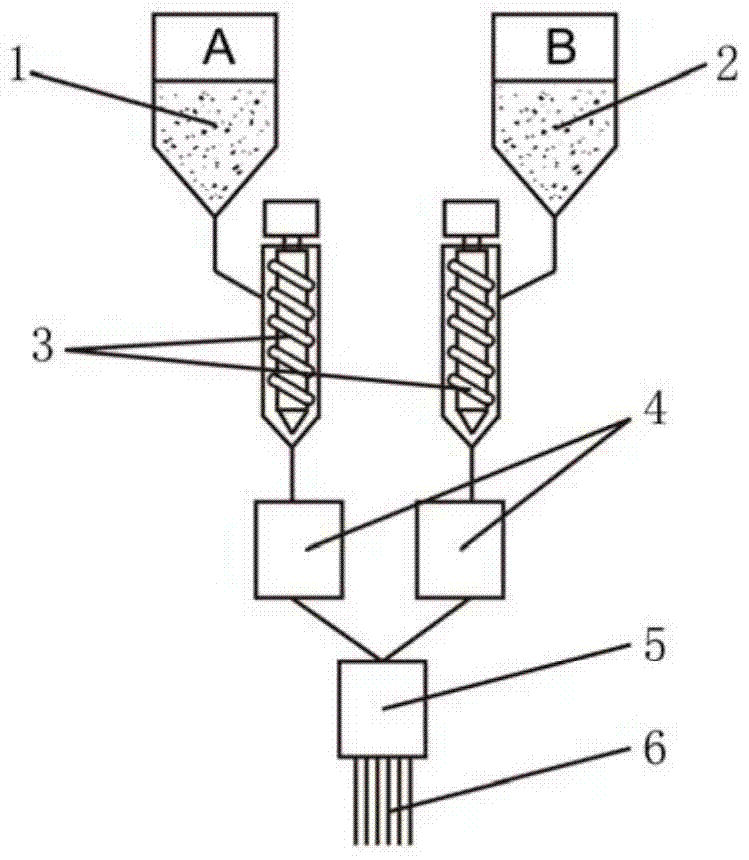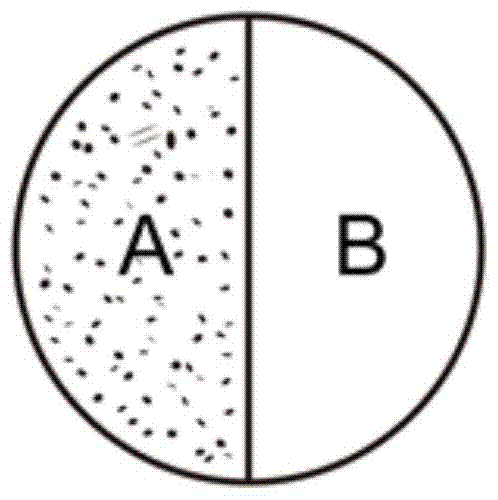A kind of flame-retardant polyamide 6 composite fiber and preparation method thereof
A technology of flame retardant polyamide and composite fiber, applied in the direction of conjugated synthetic polymer rayon, etc., can solve the problem of monotonous melting point, etc., and achieve the effect of good flame retardant effect, little impact on mechanical properties, and lasting flame retardant effect.
- Summary
- Abstract
- Description
- Claims
- Application Information
AI Technical Summary
Problems solved by technology
Method used
Image
Examples
Embodiment 1
[0049] A preparation method of flame-retardant polyamide 6 composite fiber, specifically comprising the following steps:
[0050] (1) Mix the flame retardant DDP, hexamethylenediamine and water, mix evenly at 50°C for 2 hours under the protection of nitrogen, then stir and react at 90°C for 2 hours, then raise the temperature to 150°C for further polymerization, and finally decompress and vacuumize, and react Finish generating flame retardant prepolymer, it is viscous liquid, number average molecular weight Mn is 1.8×10 3 , the molar ratio of flame retardant DDP, hexamethylenediamine and water is 1:1.1:2, and the two ends of the obtained flame retardant prepolymer are active end groups of carboxyl and amine groups respectively;
[0051] The structure of the flame retardant is:
[0052]
[0053] (2) 90.7 parts by mass of caprolactam, 4.0 parts by mass of water and 0.3 parts by mass of adipic acid are added to the reactor, and N 2 Exhaust the air in the kettle, stir at a sp...
Embodiment 2
[0062] A preparation method of flame-retardant polyamide 6 composite fiber, specifically comprising the following steps:
[0063] (1) Mix the flame retardant CEPPA, hexamethylenediamine and water, mix evenly at 80°C for 3 hours under the protection of nitrogen, then stir and react at 130°C for 3 hours, then raise the temperature to 180°C for further polymerization, and finally decompress and vacuumize, react Finish generating flame retardant prepolymer, it is semi-solid, number average molecular weight Mn is 2.5 * 10 3 , the molar ratio of flame retardant CEPPA, hexamethylenediamine and water is 1:1.2:2.5, and the two ends of the obtained flame retardant prepolymer are active end groups of carboxyl and amine groups respectively;
[0064] The structure of the flame retardant is:
[0065]
[0066] (2) 88.5 parts by mass of caprolactam, 1.5 parts by mass of water and 0.5 parts by mass of adipic acid are added to the reactor, and N 2 Exhaust the air in the kettle, stir at a s...
Embodiment 3
[0075] A preparation method of flame-retardant polyamide 6 composite fiber, specifically comprising the following steps:
[0076] (1) Mix the flame retardant BCPPO, hexamethylenediamine and water, mix evenly at 60°C for 2.5 hours under the protection of nitrogen, then stir and react at 95°C for 2 hours, then raise the temperature to 160°C for further polymerization, and finally vacuumize under reduced pressure, At the end of the reaction, a flame retardant prepolymer is generated, which is a viscous liquid with a number average molecular weight Mn of 2.8×10 3 , the molar ratio of flame retardant BCPPO, hexamethylenediamine and water is 1:1.2:2.1, and the two ends of the obtained flame retardant prepolymer are active end groups of carboxyl and amine groups respectively;
[0077] The structure of the flame retardant is:
[0078]
[0079](2) 92.9 parts by mass of caprolactam, 0.8 parts by mass of water and 0.8 parts by mass of adipic acid are added to the reactor, and N 2 Ex...
PUM
| Property | Measurement | Unit |
|---|---|---|
| limiting oxygen index | aaaaa | aaaaa |
| elongation at break | aaaaa | aaaaa |
| limiting oxygen index | aaaaa | aaaaa |
Abstract
Description
Claims
Application Information
 Login to View More
Login to View More - R&D
- Intellectual Property
- Life Sciences
- Materials
- Tech Scout
- Unparalleled Data Quality
- Higher Quality Content
- 60% Fewer Hallucinations
Browse by: Latest US Patents, China's latest patents, Technical Efficacy Thesaurus, Application Domain, Technology Topic, Popular Technical Reports.
© 2025 PatSnap. All rights reserved.Legal|Privacy policy|Modern Slavery Act Transparency Statement|Sitemap|About US| Contact US: help@patsnap.com



